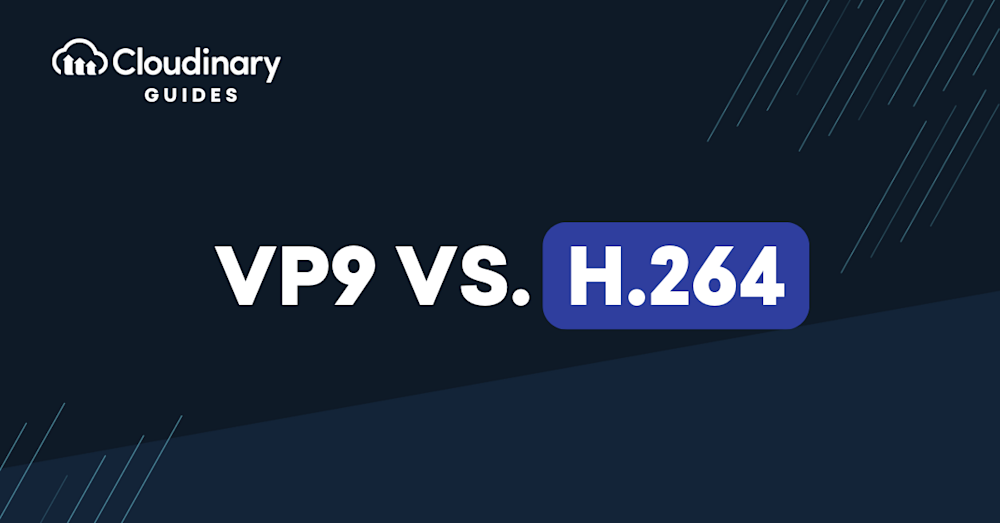What Is VP9?
VP9 is an open-source video codec developed by Google. It was designed to improve upon the VP8 codec’s compression efficiency while maintaining compatibility with existing web standards. VP9 is known for its ability to deliver high-quality video at lower bitrates compared to other codecs.
First released in 2010, it became available to the wider public in 2013. It is currently used by popular streaming services such as YouTube and Netflix to deliver high-quality video content to their users.
What Is H.264?
H.264, also known as MPEG-4 Advanced Video Coding (AVC), is a video compression standard widely used in various applications, including video recording, broadcasting, and distribution over the internet. It uses advanced algorithms to compress video content while maintaining high quality, resulting in smaller file sizes and efficient transmission. H.264 is supported by many devices and platforms, making it a popular choice for video content delivery.
This is part of a series of articles about video format
In this article:
History of VP9
The developmental work on what came to be known as VP9 began in the second half of 2011, initially under the names of Next Gen Open Video (NGOV) and VP-Next. The primary design goals for VP9 Codec were to slash the bitrate by 50% compared to its predecessor, VP8, and achieve superior compression efficiency than the MPEG High Efficiency Video Coding (HEVC) standard, all the while preserving similar video quality. By June 2013, the “profile 0” of VP9 was finalized, with Google’s Chrome browser supporting VP9 Codec video playback by August 2013.
Support for VP9 from hardware vendors has been vital for its growth. Collaborations with companies like Ittiam and ARM resulted in demonstrations of VP9 decoding for ARM Cortex devices. By early 2015, VP9 support was announced by Nvidia in its Tegra X1 SoC, and by VeriSilicon in its Hantro G2v2 decoder.
As part of the ongoing efforts to enhance VP9, a significant update was introduced to Google’s libvpx library in April 2015, expanding support for 10-bit and 12-bit bit depth, as well as introducing enhancement for 4:2:2 and 4:4:4 chroma subsampling and VP9 multithreaded decoding/encoding. Today, VP9 is used by prominent streaming services, such as YouTube and Netflix, to deliver high-quality video content at efficient bitrates.
History of H.264
The development of the H.264/AVC standard began from a call for proposals in early 1998 by the Video Coding Experts Group (VCEG). They issued a project named H.26L with a goal to double the coding efficiency, effectively halving the bit rate required for a specific fidelity level, compared to earlier video coding standards. The initiative was geared towards an array of applications. VCEG, led by Gary Sullivan, adopted the first draft design for the new standard in August 1999, and by 2000, Thomas Wiegand became a co-chair of VCEG, fueling further progress in the development of the H.264 standard.
The development of H.264 took a significant turn when VCEG partnered with the Moving Picture Experts Group (MPEG) in December 2001 to form a Joint Video Team (JVT). The objective of the JVT was to finalize the video coding standard, which received formal approval in March 2003. The leadership of the JVT comprised of Gary Sullivan, Thomas Wiegand, and Ajay Luthra. Following the initial approval, the JVT embarked on extension projects of H.264/AVC including the Fidelity Range Extensions (FRExt) finalized in 2004, Scalable Video Coding (SVC) from 2005 to 2007, and Multiview Video Coding (MVC) from 2006 to 2009, which were focused on enhancement and scalability of the standard.
VP9 vs. H264: Key Differences
VP9 and H.264 are both popular video codecs, but they have some key differences. Here are the main distinctions between the two:
Compression Efficiency
VP9 offers better compression efficiency than H.264, enabling higher video quality at lower bit rates. This is particularly beneficial for streaming services and users with limited bandwidth, as it helps reduce buffering and improve playback performance. The improved compression is achieved through various advanced techniques and algorithms, including larger block sizes, more advanced intra-prediction modes, and better motion compensation methods.
However, the improved compression efficiency of VP9 comes at the cost of increased computational complexity, which may require more processing power for encoding and decoding. This can be a concern for real-time applications, such as video conferencing or live streaming, where low-latency encoding and decoding are essential. Furthermore, the increased complexity can impact device performance, particularly for lower-end hardware, leading to higher power consumption and potentially reduced battery life.
In contrast, H.264 has been widely adopted due to its balance between compression efficiency and computational complexity. While it may not achieve the same level of compression as VP9, it still provides good video quality at lower bit rates and is well-suited for a wide range of applications and devices.
Licensing
One of the key differences between VP9 and H.264 lies in their licensing models. VP9 is an open-source and royalty-free codec, developed by Google as part of the WebM Project. This means that it can be used freely without incurring any licensing fees, making it an attractive option for developers and service providers looking to reduce costs and avoid potential legal issues related to patent licensing.
On the other hand, H.264 is a proprietary codec that requires licensing fees for its usage. The licensing terms for H.264 are managed by the MPEG Licensing Authority (MPEG-LA), which represents various patent holders. This can be a concern for some developers and service providers, as the licensing fees may add up, particularly for large-scale deployments or when reaching a broad audience.
Despite the licensing costs, H.264 has become the dominant video codec in the market due to its widespread adoption and compatibility across various platforms and devices. The decision to choose between VP9 and H.264 will depend on factors like cost, legal considerations, and the target audience or platforms.
Adoption and Compatibility
H.264 has been widely adopted across various platforms, devices, and applications since its release in 2003. Its widespread adoption can be attributed to its balance between compression efficiency and computational complexity, as well as its support for a wide range of resolutions and bitrates. As a result, H.264 is supported by most video players, streaming services, and hardware devices, making it a universally compatible codec.
VP9, released in 2013, has gained significant traction, particularly among web-based platforms like YouTube, which have adopted it as one of their primary video codecs. The primary reasons for this adoption include its improved compression efficiency and royalty-free licensing model. However, VP9’s adoption is not as widespread as H.264, and some devices or players may not support it natively.
The choice between VP9 and H.264 largely depends on the target audience, platforms, and devices. While VP9 may offer better compression and a royalty-free model, its compatibility may be limited, particularly for older or less popular devices. In contrast, H.264’s widespread support ensures broader compatibility, which can be crucial for reaching a larger audience or ensuring a seamless user experience.
Related content: Read our guide to VP8 vs. VP9
Pro Tip!Consider Cloudinary’s Adaptive Bitrate Streaming
Deliver videos instantly without buffering using on-the-fly encoding and automatic format and quality selection.
VP9 vs. H264: How to Choose
Choosing between VP9 and H.264 depends on several factors, including your target devices, performance requirements, network conditions, licensing concerns, and compatibility. Here are some key considerations to help you decide between the two codecs:
- Compression efficiency: If your primary concern is maximizing video quality at lower bit rates or reducing bandwidth usage, VP9 may be the better choice due to its superior compression efficiency. This is particularly beneficial for high-resolution content or when catering to users with limited bandwidth.
- Performance and power consumption: If you need to prioritize encoding and decoding speed or have concerns about power consumption on mobile devices, H.264 might be more suitable, as it provides a balance between compression efficiency and computational complexity. VP9’s increased complexity can impact performance and energy efficiency, especially on older or lower-end hardware.
- Compatibility: H.264 is widely supported across various platforms, devices, and applications, making it a universally compatible codec. If you need to ensure broad compatibility, especially with older devices or less popular platforms, H.264 is the safer choice. While VP9 has gained significant traction, its adoption is not as widespread as H.264.
- Application: Consider your specific use case, such as video streaming, video conferencing, or video storage. If you’re working with a web-based platform, VP9 might be more suitable, as it’s often used by web-based services like YouTube. For other applications, such as video conferencing or digital television broadcasts, H.264’s widespread adoption and performance balance might make it the preferred option.
Ultimately, the choice between VP9 and H.264 will depend on your unique requirements and priorities. You may need to evaluate each codec in the context of your specific use case to determine which one offers the best balance of compression efficiency, performance, and compatibility.
Cloudinary for VP9 and H.265
When it comes to choosing the right video codec for your needs, several factors come into play. Whether you prioritize the seamless compatibility and balance offered by H.264 or the superior compression and royalty-free terms of VP9, the decision ultimately depends on your unique use-case and specific requirements.
Consider an efficient storage and delivery solution like Cloudinary that supports a wide range of video formats, including both VP9 and H.264. Cloudinary platform not only simplifies your video management processes but also automatically ensures optimal format delivery based on user’s device and browser type.
Its dynamic video transcoding and adaptive bitrate streaming methods can further enhance the user experience by providing top-quality video content delivery adjusted to each viewer’s unique environmental conditions. No matter the choice of codec, partnering with Cloudinary ensures successful and efficient video content management and delivery.


